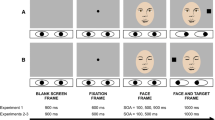Abstract
Previous research has shown that saccadic reaction times (SRTs) are shorter when a stimulus is flashed on the same side as the observed gaze direction of another individual. The gaze imitation hypothesis contends that observed gaze evokes the preparation of a saccade toward the same direction. Previous studies of this phenomenon have employed pro-saccade tasks in which the instructed saccade is directed toward the stimulus. In agreement with previous findings, we found that SRTs on pro-saccade trials were shorter when the stimulus appeared in the same direction as observed gaze. Here we also included anti-saccade trials in which subjects were required to look-away from a stimulus and toward its mirror position in the opposite visual field. The gaze imitation hypothesis predicts that subjects will have shorter SRTs on anti-saccade trials in which the stimulus appears opposite the observed gaze direction because they will have prepared already a saccade in that direction. However, contrary to the prediction of the gaze imitation hypothesis, we found that subjects had shorter SRTs on anti-saccade trials when the stimulus appeared in the same direction as observed gaze. Moreover, subjects also made more pro-saccade errors on anti-saccade trials in which the stimulus was presented opposite the observed gaze direction. The results of our study indicate that subjects prepared a saccade in the same direction as observed gaze on pro-saccade trials but opposite the observed gaze direction on anti-saccade trials. These findings suggest that the effect of social gaze cues on SRTs is task dependent.


Similar content being viewed by others
References
Brauer J, Call J, Tomasello M (2005) All great ape species follow gaze to distant locations and around barriers. J Comp Psychol 119:145–154
Campbell R, Heywood CA, Cowey A, Regard M, Landis T (1990) Sensitivity to eye gaze in prosopagnosic patients and monkeys with superior temporal sulcus ablation. Neuropsychologia 28:1123–1142
Deaner RO, Platt ML (2003) Reflexive social attention in monkeys and humans. Curr Biol 13:1609–1613
DeSouza JF, Menon RS, Everling S (2003) Preparatory set associated with pro-saccades and anti-saccades in human investigated with event-related fMRI. J Neurophysiol 89:1016–1023
DeSouza WC, Eifuku S, Tamura R, Nishijo H, Ono T (2005) Differential characteristics of face neuron responses within the anterior superior temporal sulcus of macaques. J Neurophysiol. DOI 10.1152/jn.00949.2004
Driver J, Davis G, Ricciardelli P, Kidd P, Maxwell E, Baron-Cohen S (1999) Gaze perception triggers visuospatial orienting by adults in a reflexive manner. Vis Cogn 6:509–540
Everling S, DeSouza JF (2005) Rule-dependent activity for prosaccades and antisaccades in the primate prefrontal cortex. J Cogn Neurosci 17:1483–1496
Everling S, Munoz DP (2000) Neuronal correlates for preparatory set associated with pro-saccades and anti-saccades in the primate frontal eye field. J Neurosci 20:387–400
Everling S, Dorris MC, Munoz DP (1998) Reflex suppression in the anti-saccade task is dependent on pre-stimulus neural processes. J Neurophysiol 80:1584–1589
Everling S, Dorris MC, Klein RM, Munoz DP (1999) Role of primate superior colliculus in preparation and execution of anti-saccades and pro-saccades. J Neurosci 19:2740–2754
Friesen CK, Kingstone A (1998) The eyes have it! reflexive orienting is triggered by nonpredictive gaze. Psychon Bull Rev 5:490–495
Friesen CK, Moore C, Kingstone A (2005) Does gaze direction really trigger a reflexive shift of spatial attention? Brain Cogn 57:66–69
Friesen CK, Ristic J, Kingstone A (2004) Attentional effects of counterpredictive gaze and arrow cues. J Exp Psychol Hum Percept Perform 30:319–329
Hallett PE (1978) Primary and secondary saccades to goals defined by instructions. Vision Res 18:1279–1296
Hallett PE, Adams BD (1980) The predictability of saccadic latency in a novel voluntary oculomotor task. Vision Res 20:329–339
Harries MH, Perrett DI (1991) Visual processing of faces in temporal cortex: physiological evidence for a modular organization and possible anatomical correlates. J Cogn Neurosci 3:9–24
Heywood CA, Cowey A (1992) The role of the “face cell” area in the discrimination and recognition of faces by monkeys. Philos Trans R Soc Lond B Biol Sci 335:31–38
Kingstone A, Friesen CK, Gazzaniga MS (2000) Reflexive joint attention depends on lateralized cortical connections. Psychol Sci 11:159–165
Kingstone A, Tipper C, Ristic J, Ngan E (2004) The eyes have it!: an fMRI investigation. Brain Cogn 55:269–271
Langton SRH, Bruce V (1999) Reflexive social orienting. Vis Cogn 6:541–567
Miller EK, Cohen JD (2001) An integrative theory of prefrontal function. Annu Rev Neurosci 24:167–2002
Munoz DP, Everling S (2004) Look away: the anti-saccade task and the voluntary control of eye movement. Nat Rev Neurosci 5:218–227
Perrett DI, Smith PAJ, Potter DD, Mistlin AJ, Head AS, Milner AD, Jeeves MA (1985) Visual cells in the temporal cortex sensitive to face view and gaze direction. Proc R Soc Lond B Biol Sci 223:293–317
Posner MI (1980) Orienting of attention. Q J Exp Psychol 32:3–25
Ricciardelli P, Bricolo E, Aglioti SM, Chelazzi L (2002) My eyes want to look where your eyes are looking: exploring the tendency to imitate another individual’s gaze. Neuroreport 13:2259–2264
Ristic J, Friesen CK, Kingstone A (2002) Are eyes special? it depends on how you look at it. Psychon Bull Rev 9:507–513
Schall JD, Morel A, King DJ, Bullier J (1995) Topography of visual cortex connections with frontal eye field in macaque: convergence and segregation of processing streams. J Neurosci 15:4464–4487
Vecera SP, Rizzo M (2005) Eye gaze does not produce reflexive shifts of attention: evidence from frontal-lobe damage. Neuropsychologia. DOI 10.1016/jneuropsychologia.2005.04.010
Acknowledgements
We thank Brian Corneil, Kevin Johnston, Matthew Brown, Courtney Field, Helen Levin, Sherry Ekstrom, and Kristen Ford for helpful comments on the manuscript. This research was supported by grants from the Natural Science Engineering Research Council of Canada (NSERC) and the EJLB foundation.
Author information
Authors and Affiliations
Corresponding author
Rights and permissions
About this article
Cite this article
Koval, M.J., Thomas, B.S. & Everling, S. Task-dependent effects of social attention on saccadic reaction times. Exp Brain Res 167, 475–480 (2005). https://doi.org/10.1007/s00221-005-0206-8
Received:
Accepted:
Published:
Issue Date:
DOI: https://doi.org/10.1007/s00221-005-0206-8




